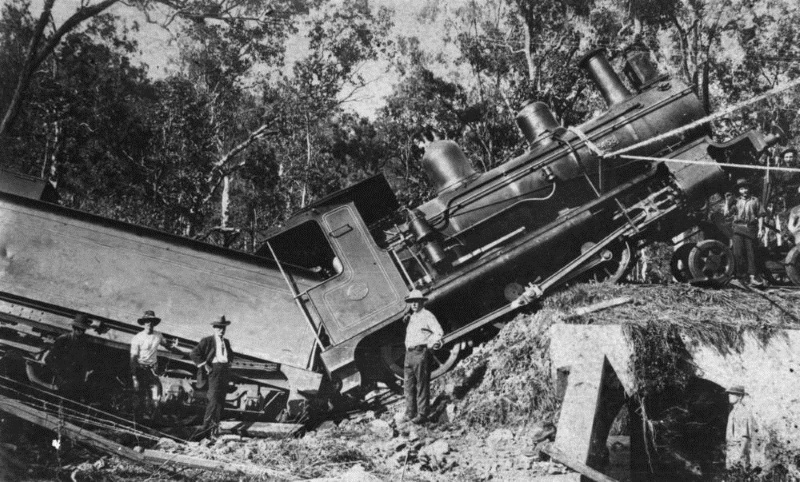Reporting then and now …
Warren Nunn
A railway accident at Tungamull more than a century ago and the matter-of-fact way in which it was reported highlight how both the media and society have dramatically changed.
The historical image tells more of the story than the newspaper report because it records details of what actually happened; a locomotive and tender fell in to a 3 m (10 ft) hole from what appears to be a collapsed bridge over a small culvert.

The scene in January 1911 of the railway accident at Tungamull on the Emu Park-Rockhampton railway line. Image: State Library of Queensland.
Imagine the media hype if such an event occurred today—there would be live TV coverage, breaking news reports on the internet; Facebook posts, Twitter alerts as well as passengers sharing photos within seconds of the incident.
As well, depending on the severity of the derailment, it would demand a front page photograph as well as considerable coverage inside the paper with various accounts from passengers and in-depth analysis of how the accident happened and how long repairs would take. No doubt, hundreds of words would be both spoken and written in the various media outlets.
Not so back in 1911 when my grandfather was a 12-year-old growing up in Rockhampton, because his family would only have had a concise 256-word account of that Tungamull event. It started in this benign and unemotional way:
The derailment of an engine tender and a waggon (it was common at the time to spell wagon with two gs), and subsequently of another engine, at Tungamull, on the Emu Park railway, considerably delayed the arrival of passengers from Emu Park, Yeppoon, and Mount Chalmers yesterday morning.
“Bare facts” newspaper reporting was all there was in The Rockhampton Morning Bulletin back then; and it wasn’t much different when I started my journalism career there in 1972.
So here’s how the paper continued telling readers what happened that day:
The train that left Emu Park at 7.20 a.m. made a halt at Tungamull as usual for the convenience of passengers and to bring along a box waggon of fruit. The trailing bodies of the tender and waggon became derailed.
This could be a bit a puzzle to younger readers unfamiliar with how the train system worked back then and even up to the late 1960s before technology began to change and road transport eventually replaced rail.
Even though it was a passenger train, stopping to add a wagon-load of produce would have been a common occurrence. Railway was a lifeline for people; you couldn’t jump in your utility and drive up to Rockhampton to deliver your pineapples to the next point in the supply chain.
As an aside my 86-year-old mum recalls as a 10-year-old having to help hand milk the family’s 60 cows when machinery broke down. That went on for a week before replacement parts arrived from Rockhampton to the farm which was only 100 km (60 miles) away on the Dawson River. That’s unheard of these days when parts can be obtained within hours.
To help resolve the Tungamull incident and get the passengers on to Rockhampton, another locomotive was sent from Yeppoon but it was derailed as well. Officials then brought along another locomotive from Mount Chalmers to get the passengers.
All this only took a few hours because by 1.30pm, the locomotives had been returned to the rails, and had arrived back in Rockhampton.
It was reported that there was no damage to the railway or the rolling stock, but, the photograph suggests that the bridge and rails were certainly a mess.
It goes to show you just can’t trust newspaper reporters sometimes—even those who plied their trade 100 years. Of course, it was much different with communication back then, so it is not surprising that there were a few gaps in the story.
Footnote: Should you want to read the original report, go to this link: http://tinyurl.com/tungamull. It will take you to the wonderful National Library of Australia website’s newspaper archives.

Recent Comments